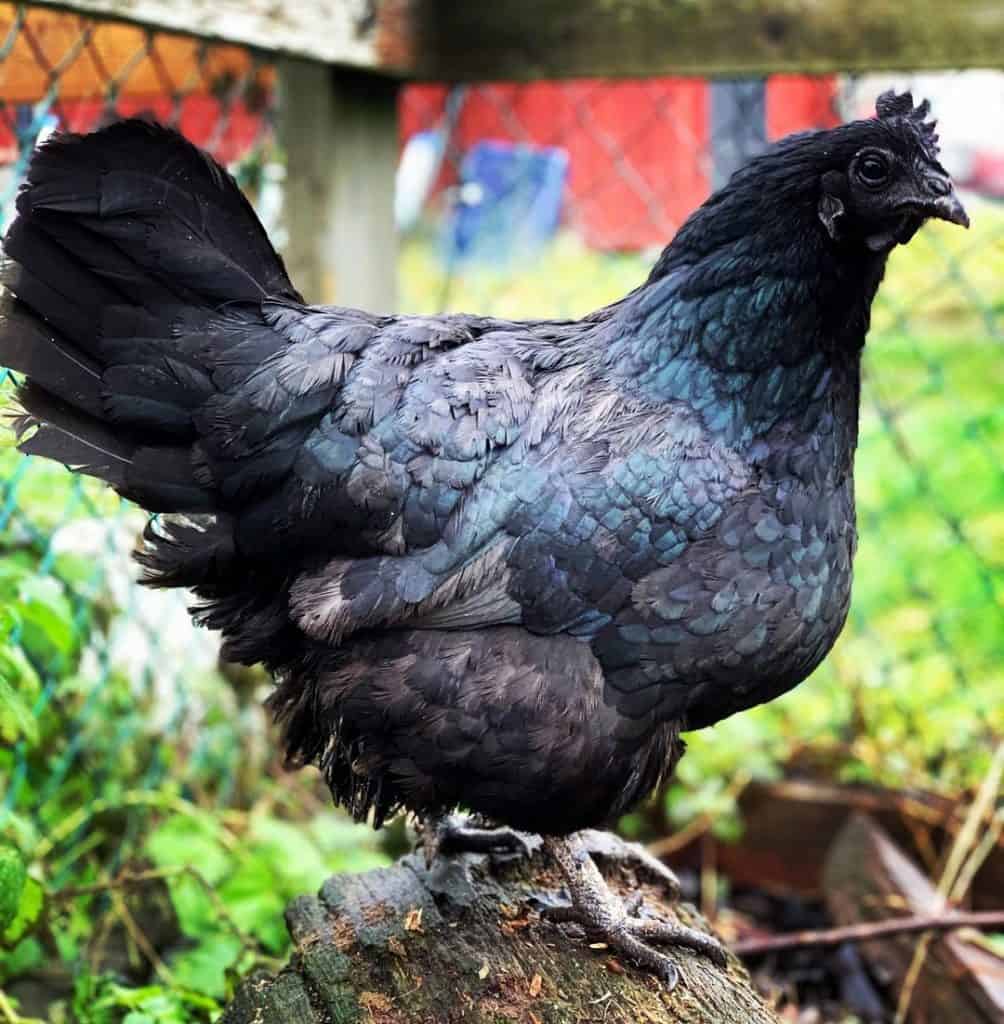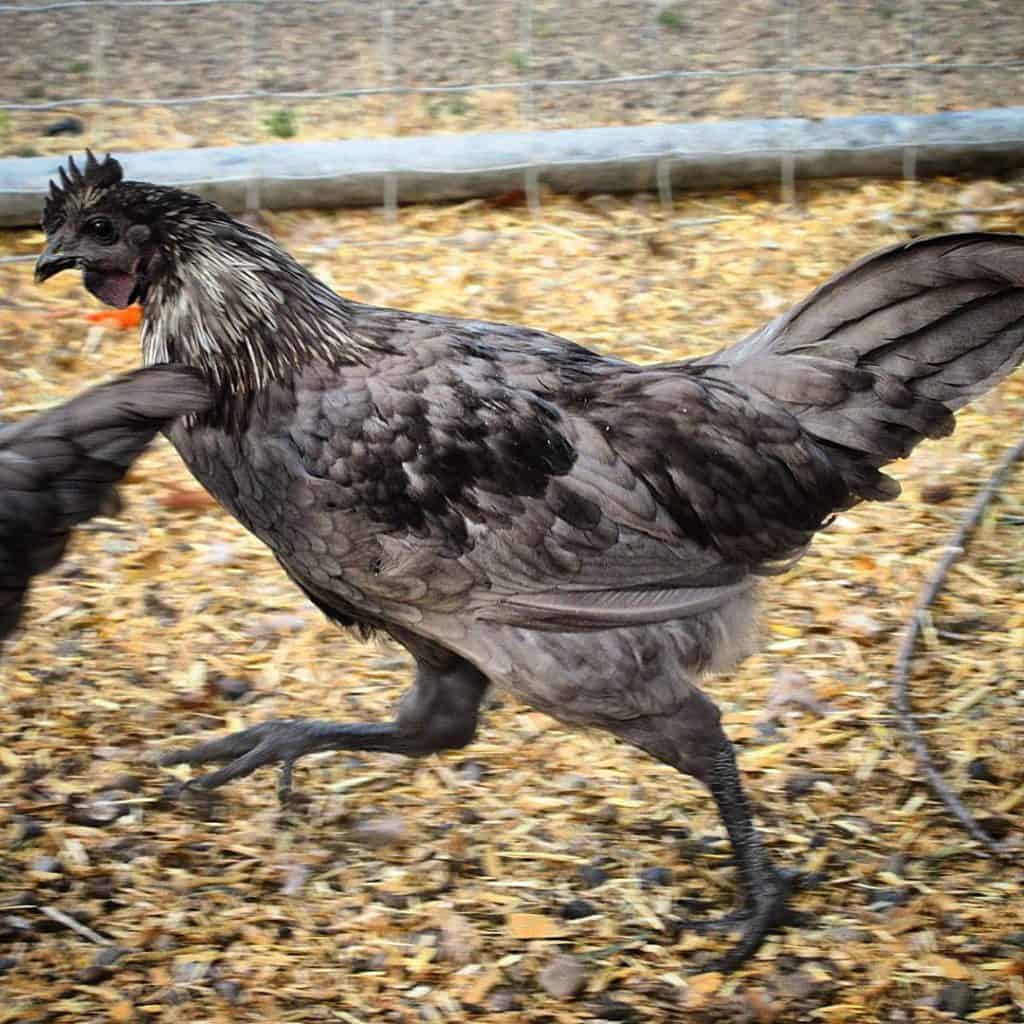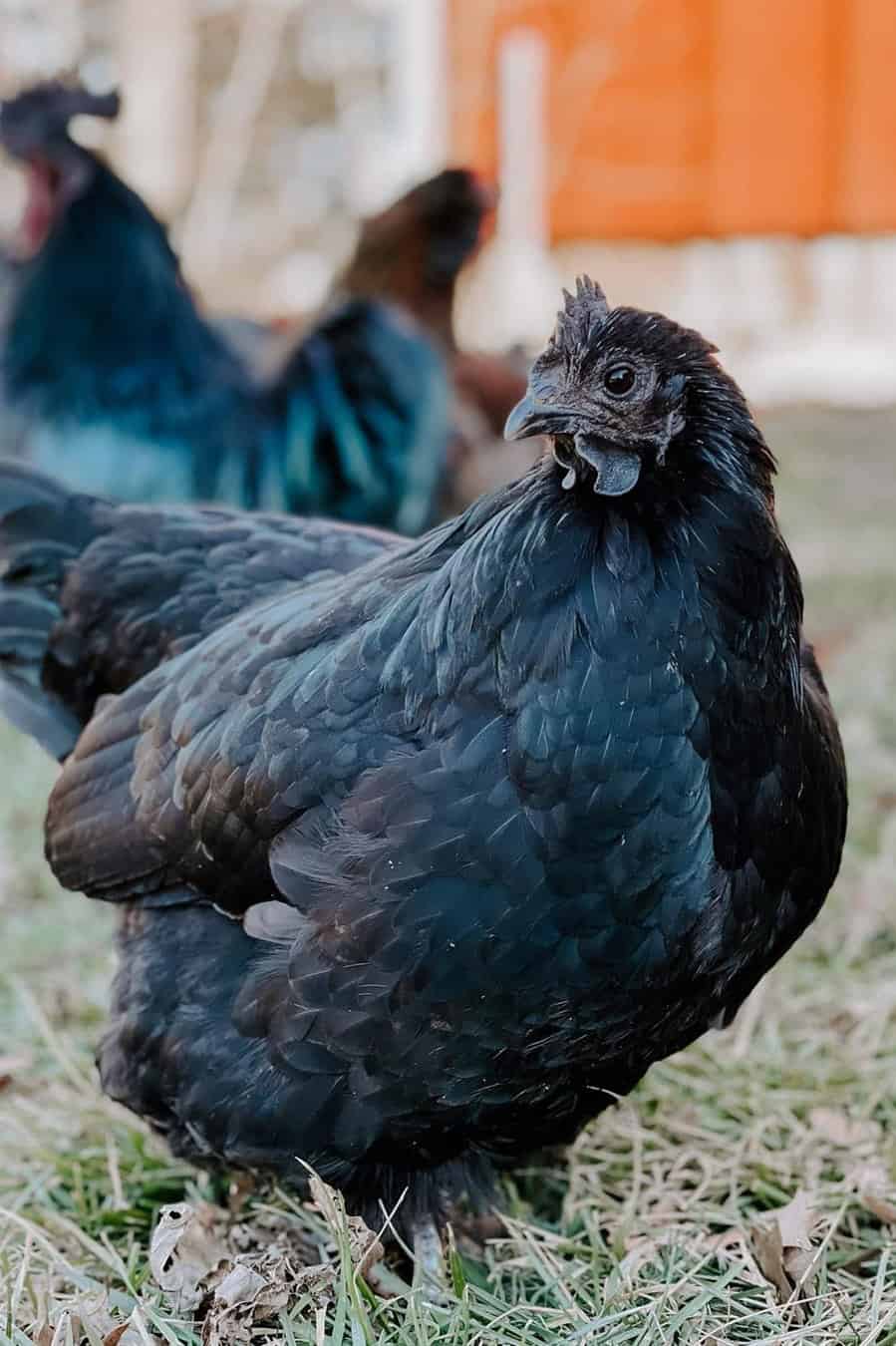For those who love unusual-looking chickens, the Svart Hona is a must-see. These birds look almost like mythical creatures–with glossy black feathers, black combs, and sleek, compact bodies, they don’t look much like your typical backyard bird. Here’s what you need to know about the mysterious Svart Hona.
| Attribute | Svart Hona Chicken Information |
|---|---|
| Purpose | Dual Purpose (meat & egg) |
| Egg Color | Off-white |
| Egg Size | Medium |
| Broody | Yes |
| Heat Tolerance | Moderate |
| Cold Tolerance | Yes |
| Comb Type | Single |
| Egg Production | 180-250 per year |
| Chicken Skin Color | Black |
| Life Span | 5-8 years |
| Adult Weight (Hen) | 4-6 lbs |
| Adult Weight (Rooster) | 5-7 lbs |
| Backyard Friendly | 4/5 |
Background and History of Svart Hona

The Svart Hona chicken, despite its Swedish name, originated in Mozambique (and likely, before that, in Indonesia). These birds were brought from Mozambique to Sweden in the 1800s, where the breed continued to develop.
Because the breed’s official country of origin is Sweden, the Svart Hona is also called the Swedish Black Hen. This breed of chicken is largely considered to be a landrace variety. This means that it developed naturally over time, with little selective breeding or deliberate breed development.
The Svart Hona looks a lot like the Ayam Cemani, another rare, all-black bird. The Ayam Cemani is thought to be a close genetic relative, and it’s a bird of Indonesian origin.
Because of the very close resemblance between the two breeds, it’s thought that the Svart Hona chicken may have originated in Indonesia, even before birds from Mozambique were brought to Sweden.
Despite their unique appearance, Svart Hona chickens remain rare, even in Sweden. In fact, a fairly recent Swedish effort to count the birds estimated that there are only about 400 in Sweden.
The breed was only brought to the United States in 2012, and it remains extraordinarily rare–the few reputable breeders in the U.S. often don’t have available stock.
It’s not known how many Svart Honas are in the United States. The breed is not recognized by the American Poultry Association, so it isn’t present on the Livestock Conservancy’s watch lists despite its rarity.
Svart Hona Breed Standard and Appearance

Since the Svart Hona chicken isn’t included in the APA’s Standard of Perfection, there is not an official breed standard. Despite that fact, this distinctive-looking breed has quite a recognizable appearance.
The most distinctive part of this breed’s appearance is the fact that it’s fibro melanistic. This means that its eyes, comb, wattles, feathers, legs, and even bones are all black.
Even the most striking black chicken varieties typically have a red comb and wattles and amber-colored eyes, so the Svart Hona has a distinctively different look–even those who aren’t familiar with chickens will likely notice that there’s something different about them.
Another distinction of the Svart Hona is its small size. It isn’t quite small enough to be considered a bantam, but the Svart Hona is typically between five pounds and 7.5 pounds, with some being as light as three pounds.
While these birds are all black, their feathers have a distinctive sheen compared to many other black chickens. They have a greenish sheen that’s only seen in certain kinds of light. The sheen is especially noticeable in the roosters.
These birds have prominent single combs and compact builds, and apart from their truly unique coloring, they look much like most people expect a chicken to look like.
While there isn’t a set breed standard, many chicken keepers who specialize in Svart Honas agree on what constitutes undesirable characteristics. Here are some things to avoid when looking for quality stock:
- Grey on the feet
- White on the wattles
- Comb and wattles that are a mulberry color instead of true black
- Eyes that are brown instead of black
- Pink coloring in the mouth
If you haven’t seen a Svart Hona chicken before, check out this video–it shows a small flock of Svart Hona hens.
Personality and Temperament
This breed is known for being especially good at free-ranging. This is because the birds’ small bodies are compact, and they are excellent flyers compared to most chicken breeds. Roosters tend to be very vigilant, and they will sound an alarm if a hawk or other danger is seen. Because Svart Honas are so lightweight, they can often roost in trees until the danger passes.
Because the Svart Hona is a landrace chicken breed, contemporary Svart Hona chickens have descended from stock that spent their days foraging for food. This makes them relatively easy keepers, but because they are so active, it’s ideal to make sure they can have plenty of space and time to forage.
And despite their small size, they seem to be very resistant to cold–some keepers even claim that their black combs are less likely to get frostbite.
You might think that birds like this would be flighty most of the time, but that’s hardly the case. Many chicken keepers who have Svart Honasreport that these birds are extremely affectionate and generally laid back.
While they can move quickly when needed, these birds often seek affection from their caregivers–they may fly up on your shoulder, follow you, or willingly sit in your lap.

Svart Hona Egg Laying
One might assume that landrace breeds aren’t especially prolific layers. And while it’s true that this chicken breed was primarily raised to be ornamental, the birds are surprisingly good layers. While egg production will usually vary depending on individual birds, a Svart Hona hen can often lay 250 eggs in a year.
The eggs are large, especially given the size of the birds, and they are off-white in color. However, this is a slow-maturing breed of chicken, and many hens don’t start laying until about 24 weeks of age.
This chicken breed is a hard one to come by, but if you manage to get a flock, you likely won’t have a hard time growing it. These birds are very fertile, and some breeders have reported a hatch rate of close to 98 percent. The hens are also fairly attentive mothers, which isn’t always seen in lighter breeds like this one.
Health Issues and Care

Most chicken keepers make sure they do their due diligence when planning to add to a flock. The good news is that this hardy breed doesn’t have a whole lot of health issues, and caring for this type of chicken isn’t unlike caring for most other breeds.
We mentioned earlier that this chicken breed has a high tolerance for cold–this is likely because it developed in Sweden, which has a fairly cold climate. And while some keepers claim that the black comb may make this breed more resistant to frostbite, it’s still important to be vigilant. These birds have larger combs than many breeds.
Since the comb extends further from the chicken’s body compared to shorter comb types like the pea comb, it’s more exposed to cold. If you live in a very cold climate, make sure that your birds have an enclosure that’s warm enough to protect them from the cold. In very cold climates, you may want to offer them a heated space.
While it isn’t necessarily a health issue, it’s important to understand that these birds have historically been accustomed to free-range foraging. Some breeds of chicken are very tolerant when it comes to being confined, but the Svart Hona is not one of them. If your birds can’t be free-range all day, make sure that they have time to roam and forage.
4 Tips for Raising Happy Svart Honas

Unlike most chicken breeds, you can’t simply order Svart Hona chicks from most hatcheries. And because these birds are so hard to find, it’s best to take your time, do some research, and make sure you raise them the right way. Here are tips to make sure you give your flock a good life.
1. Be Careful With Sourcing
This isn’t necessarily a care issue, but if you’re looking to raise a true Svart Hona chicken (or a flock of many), it’s important to make sure you get one from quality stock.
Don’t just buy from the first seller you can find online–take your time and ask around. Many people who raise Svart Honas are passionate about the breed, and they can often point you towards a reputable breeder. Recommend read: Buying Chickens: The How, Why, What, When, and Where?
2. Give Them Plenty of Space
These are birds who love to roam, and they are very good at protecting themselves from danger. Ideally, if you need to keep your flock in a chicken coop for some of the time, get a coop with an attached run.
This will offer your birds some foraging room. When you can, let them forage freely, even with supervision. Since they descended from birds who were essentially free-range, Svart Honas are happier when they can have time to roam freely.

3. Be Patient
As chicken breeds go, the Svart Hona is a slow-maturing one. Pullets don’t usually start laying until about 24 weeks, and some breeders have even observed that the chicks take a long time to come out of their eggs after first cracking the shell.
4. Spend Time With Them
The Svart Hona chicken is a bird that generally loves people. If you want a flock that’s especially sociable, spend some time each day holding and talking to your birds. They will quickly realize you aren’t a threat, and some may start coming up to you and following you around.
In Conclusion
If you’re looking for a stunning chicken breed that has a decent egg layer and is also friendly, the Svart Hona is an excellent choice. Their rarity makes them a true prize, too–make sure that you research breeders and source from quality stock, and then enjoy raising a flock of beautifully unique birds.

Joseph Hudson has been raising chickens for over 15 years. In 2018, he completed the Agriculture & Natural Resources program at Mt. San Antonio College. He currently raises over 1400 chickens on his 7.5-hectare farm. He keeps sharing his experience on raising healthy and happy chickens on Chicken Scratch The Foundry.








I love the Svart Hona! Where can i buy them?
Thank you for reading our article. Svart Hona is a very rare chicken breed and is generally quite expensive. Typically, only local rare hatcheries offer these chicks.